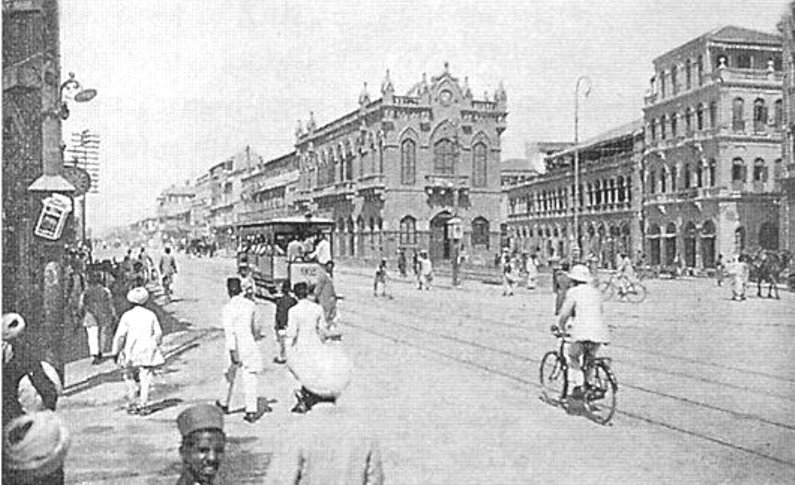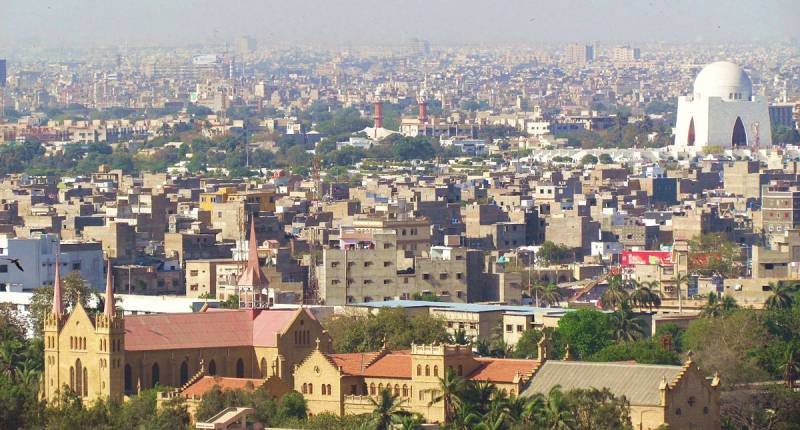Karachi Then and Now
Karachi Then
Karachi, the bustling metropolis and capital of Sindh province in southern Pakistan has a rich history that dates back to its origins as a small settlement known as Kolachi-jo-Goth.
Founded around 1729 during the rule of the Kalhora dynasty, this village is thought to have been named after Mai Kolachi, a local figure whose son famously killed a man-eating crocodile that had terrorized the area, having already claimed the lives of her other sons.
Over time, the name evolved, and the settlement became known as Karachi, a shortened and altered version of its original name.
The first recorded use of the name Karachi appeared in a Dutch report from 1742, which documented a shipwreck near the area.
Today, Karachi is one of the largest cities in Pakistan, serving as a major commercial and cultural hub, while its historical roots continue to shape its identity.

Karachi History
Karachi’s history traces its origins back to a small fishing village before evolving into one of the most significant cities in Pakistan.
In the early 18th century, traders from the decaying port of Kharak Bandar moved to Karachi due to its strategic location, offering natural protection against monsoon storms.
The settlement expanded rapidly, benefiting from the defensive position provided by Manora Head. In 1795, Karachi was taken over by the Talpura amīrs, who built a fort on Manora Island to defend the harbour.
By 1839, the British captured the city, annexing it in 1842 along with the province of Sindh. The British recognized Karachi’s potential and transformed it from a small fishing village into a major port for the region.
Related Article: Istanbul Then and Now
Under British rule, the city’s infrastructure began to develop rapidly. In 1843, a river-steamer service was introduced to connect Karachi to the inland city of Multān.
Improvements to the port began in 1854, and in 1861, a railway connecting Karachi to Kotri was established, further boosting the city’s connectivity.
With the opening of the Suez Canal in 1869, Karachi’s importance grew as a key seaport for trade between Europe, the Middle East, and the Indian subcontinent. By 1873, the city boasted a well-managed and efficient harbor.
The establishment of the Karachi Port Trust in 1886 and the construction of the East Wharf between 1888 and 1910 cemented Karachi’s position as a major trading hub.
Related Article: Riyadh Then and Now
By the early 20th century, Karachi was the largest grain-exporting port of the British Empire.
After World War I, the city saw an increase in manufacturing and service industries, and by 1924, an aerodrome was built, making Karachi the main point of entry to India.
The city continued to grow in importance and became the provincial capital of Sindh in 1936. Upon the creation of Pakistan in 1947, Karachi became the capital and the country’s premier port.
Although Rawalpindi temporarily served as the interim capital in the 1950s and 1960s before Islamabad took on the role in 1969, Karachi remained the heart of Pakistan’s business and industry.
Related Article: Abu Dhabi Then and Now
However, Karachi’s rapid economic growth in the second half of the 20th century came with challenges.
The city experienced a massive influx of immigrants from rural areas, leading to a population explosion.
Many of these immigrants settled in sprawling urban slums, known as katchi abadis, lacking basic amenities such as water, sanitation, and electricity.
The city’s infrastructure struggled to keep up with the growing population, leading to an ongoing challenge in providing basic city services.
Related Article: Doha Then and Now

Throughout the late 20th century, Karachi became plagued by ethnic violence, particularly between the native Sindhis and the more recent muhājir (immigrant) communities from India.
The situation worsened with the arrival of large numbers of Pashtuns from the north, further exacerbating ethnic tensions.
This violence, along with increasing crime rates, led the government to launch a military crackdown in 1992.
While the city witnessed some improvements in security by the end of the decade, lawlessness remained a significant issue, and the city’s infrastructure continued to deteriorate.
Related Article: Ahmedabad Then and Now
By the early 21st century, Karachi continued to suffer from crime, political instability, and poor infrastructure.
In 2013, the Pakistani government launched another military operation to address the growing violence and crime.
Additionally, reforms at the provincial level sought to decentralize municipal services, but the confusion over responsibility for these services left Karachi’s infrastructure in poor shape.
Despite some improvements, the city’s challenges with governance, crime, and urban management remained an ongoing concern as it continued to grow.
Related Article: Hyderabad Then and Now
Karachi Now

Karachi, the capital city of Sindh province, is Pakistan’s largest and most cosmopolitan metropolis, playing a crucial role as the country’s industrial and financial center.
Situated along the Arabian Sea coast at the southern tip of Pakistan, Karachi is one of the most populous cities in the world, with over 20 million residents, according to the 2023 census.
It was originally a small fishing village known as Kalachi-jo-Goth in the 18th century, and its name evolved over time into variations like Caranjee, Currachee, and finally Karachi.
Related Article: Bengaluru Then and Now
The city’s strategic location near the Indus River delta and its role as a port for the surrounding agricultural regions fueled its growth and development, particularly after British colonial rule.
Karachi became the capital of Pakistan following the country’s independence in 1947 before it was moved to Islamabad in 1969, though Karachi remained the country’s economic hub.
Karachi has experienced significant economic growth since Pakistan’s independence, largely driven by its role as the primary seaport and a critical industrial center.
Related Article: Chennai Then and Now
The city’s economy is the largest in Pakistan, with a formal GDP estimated at $190 billion as of 2021.
Karachi generates approximately 25% of the country’s GDP and is responsible for 35% of its tax revenue. It also accounts for around 30% of Pakistan’s industrial output.
As the heart of Pakistan’s trade, Karachi’s ports, including the Port of Karachi and Port Qasim, handle about 95% of the country’s foreign trade.
Related Article: Fukuoka Then and Now
The city is home to nearly all of Pakistan’s multinational corporations and banking institutions, with 90% of foreign banks having their headquarters in Karachi.
Additionally, the city is a major transport hub with Jinnah International Airport, Pakistan’s busiest, facilitating both domestic and international travel.
In terms of cultural significance, Karachi is regarded as Pakistan’s fashion capital, hosting major events such as the Karachi Fashion Week.
Related Article: Nagoya Then and Now
It is also known for its vibrant history and cosmopolitan culture, which has drawn migrants from all parts of Pakistan and beyond, creating a highly diverse society.
Karachi hosts large communities of people from various ethnic backgrounds, including Sindhis, Punjabis, Pashtuns, Muhajirs (immigrants from India), as well as significant populations of Bengalis, Afghans, and Rohingyas.
The city’s multicultural makeup is reflected in its diverse language, religion, and traditions.
Related Article: Osaka Then and Now
However, Karachi’s rapid growth and its status as an economic powerhouse have come with challenges.
The city has struggled with ethnic, sectarian, and political violence, particularly since the 1980s, when the arrival of weapons during the Soviet-Afghan War exacerbated tensions.
In the years that followed, Karachi became notorious for its high crime rates, which included gang violence, terrorism, and political unrest.
Related Article: Busan Then and Now
To address this, the Pakistan Rangers launched a military operation in 2013 aimed at reducing crime, targeting criminal gangs, political factions, and Islamist militants.
The operation succeeded in reducing violence significantly, and by 2022, Karachi had dropped from being ranked the 6th most dangerous city in the world for crime to 128th.
Despite these improvements, Karachi continues to face challenges related to rapid urbanization.
The influx of millions of migrants has strained the city’s infrastructure, resulting in overcrowded areas, inadequate sanitation, and a shortage of basic services in many parts of the city.
Related Article: Taipei Then and Now
Slums, known as katchi abadis, have proliferated as a result, with many people living without reliable access to electricity, water, or sanitation.
These ongoing issues highlight the need for effective urban planning and governance to address the growing demands of Karachi’s diverse population.
Overall, Karachi stands as a city of contrasts, balancing its role as a commercial and industrial powerhouse with the complexities of urban growth and social challenges.
It remains Pakistan’s most important city, continuing to drive the nation’s economy and shape its cultural and political landscape.
Related Article: Ho Chi Minh City Then and Now
FAQs
Karachi is famous worldwide as Pakistan’s largest city, its primary seaport, and a major financial and industrial hub.
It handles 95% of the country’s foreign trade, has a diverse population, and is a key center for business, fashion, and culture in Pakistan.
Lahore is often referred to as the “Paris of Pakistan” due to its rich cultural heritage, historical significance, and vibrant arts scene, much like Paris in France.
Karachi is the biggest city in Pakistan by population, with over 20 million residents, making it not only the largest in Pakistan but also one of the largest cities in the world.
Karachi is still known by its name, but it has been nicknamed the “City of Lights” in the past, especially during the 1960s and 1970s, due to its vibrant nightlife and cosmopolitan atmosphere.






























